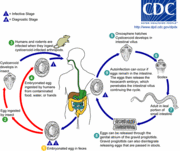Hymenolepiasis
Hymenolepiasis is infestation by one of two species of tapeworm: more...
- Hymenolepis nana
- Hymenolepis diminuta
Alternative names are:
- Dwarf tapeworm infection
- Rat tapeworm
Causes, incidence, and risk factors
Hymenolepis worms live in warm climates and are common in the southern USA. The eggs of these worms are ingested by insects, and mature into a life form referred to as a "cysticercoid" in the insect. In H. nana, the insect is always a beetle. Humans and other animals become infected when they intentionally or unintentionally eat material contaminated by insects. In an infected person, it is possible for the worm's entire life-cycle to be completed in the bowel, so infection can persist for years. Hymenolepis nana infections are much more common than Hymenolepis diminuta infections in humans because, in addition to being spread by insects, the disease can be spread directly from person to person by eggs in feces. When this happens, H. nana oncosphere larvae encyst in the intestinal wall and develop into cysticercoids and then adults. These infections were previously common in the southeastern USA, and have been described in crowded environments and individuals confined to institutions. However, the disease occurs throughout the world. H. nana infections can grow worse over time because, unlike in most tapeworms, H. nana eggs can hatch and develop without ever leaving the definitive host.
A study in Connecticut found that one third of rats sold in pet stores were infected with H. nana and concluded that these and other rodents sold in pet stores pose a potential threat to public health.
Symptoms
Symptoms occur only with heavy infections, which are rare in adults because of their better-developed immune systems. Symptoms include:
- gastrointestinal system discomfort
- diarrhea
- weakness
- anorexia (poor appetite)
Signs and tests
Examination of the stool for eggs and parasites confirms the diagnosis. H. nana eggs and proglottids are smaller than in H. diminuta. Proglottids of both are relatively wide and have three testes. Identifying the parasites to the species level is often unnecessary from a medical perspective, as the treatment is the same for both.
Treatment
Praziquantel as a single dose is the current treatment of choice for hymenolepiasis. Niclosamide is also used to treat infection with adult worms.
Prognosis
Expect full recovery following treatment.
Complications
- abdominal discomfort
- dehydration from prolonged diarrhea
Read more at Wikipedia.org



